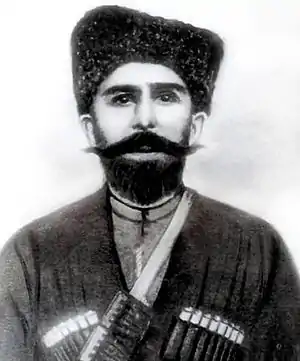Zelimkhan
Zelimkhan Kharachoevsky (January 1872; Kharachoy, Terek Oblast – 26 September 1913; born Zelimkhan Gushmazukayev[1]) and better known simply as Zelimkhan was a Chechen outlaw (known locally as an abrek) who gained fame in the late Russian Empire due to his spectacular bank and train robberies as part of a violent struggle with the Russian authorities. Since the Russian Revolution he has been mythologized as a version of a Chechen Robin Hood, first by the Bolsheviks (for fighting against the Tsarist regime) and later by Chechen nationalists.[2] Today the name Zelimkhan is given to Chechen and Ingush children.

During the early 20th century, after the events of 1905, Zelimkhan was a particular problem for the Russian governors of the restive region, and enjoyed the support of the local population.[3] He would ultimately become a symbol of triumph over the Russian administration, committing brazen feats such as the robbery of the Kizlyar treasury, carried out in broad daylight on March 27, 1910[4] and distributed the money to poor people;[5] he became varyingly seen as a fighter for "justice" or as one who continued the fight of the Muslim population for independence from Russia, being compared to Imam Shamil.[4]
There is a statue of Zelimkhan outside the site of the village of Serzhen Yurt, which was destroyed during the First Chechen War.[6]
Chechen folk song about Zelimkhan
There is a popular folk song about Zelimkhan.[7]
References
- Urushadze, Amiran. The Caucasus in the Late 19th – Early 20th Centuries: Problems of Governance and Modernization on the Southern Outskirts of the Russian Empire. Quaestio Rossica.
- Jeronim Perovic, Imperial Projections and Caucasian Realities. Banditry and the Zelimkhan Phenomenon in Late Imperial Russia, in Jahrbücher für Geschichte Osteuropas 62(1):30-60.
- Amiran Urushadze. "The Caucasus in the Late 19th – Early 20th Centuries: Problems of Governance and Modernization on the Southern Outskirts of the Russian Empire". Quaestio Rossica: 145. doi:10.15826/qr.2015.2.101. hdl:10995/31976.
Лидер одной из таких групп, легендарный Зелимхан Гушмазукаев пользовался поддержкой среди местного населения и представлял большую угрозу для официальных властей. Использование против недовольных исклю...
- Amiran Urushadze. "The Caucasus in the Late 19th – Early 20th Centuries: Problems of Governance and Modernization on the Southern Outskirts of the Russian Empire". Quaestio Rossica: 152. doi:10.15826/qr.2015.2.101. hdl:10995/31976.
Символом бессилия российской администрации стали сме-лые действия отрядов, возглавляемых Зелимханом Гушмазукаевым. Самой отчаянной акцией абреков Зелимхана стало ограбление Киз-лярского казначейства 27 марта 1910 г., совершенное открыто, при свете дня. Секрет неуловимости Зелимхана был в его народной по-пулярности. Для многих жителей Терской области он был далеко не просто удачливым бандитом, но борцом за справедливость. Иногда его имя связывалось с идеей продолжения борьбы, к которой мусуль-ман Кавказа призывал и которую долгие годы возглавлял имам Ша-миль. Российская агентура даже имела сведения, согласно которым Зелимхан в 1909 г. на съезде старейшин селений Терской и Дагестан-ской областей был провозглашен святым и великим имамом...
- Lemka T. Agieva (2020). "Абречество как одна из форм социального протеста". Nasledie Vekov: 94. doi:10.36343/SB.2020.21.1.008.
Зелимхан со своими сподвижниками ограбил Кизлярский банк и деньги (золото) раздал бедным людям. Доказательством тому явля-ется «Прошение», которое абрек направил 15 января 1909 г. на имя председателя III Госу-дарственной Думы октябриста Н. А. Хомякова: «Хозяйства, как сосланных, так и заключен-ных, совершенно разорились, жены, и дети их живут подаянием добрых людей, да тем, что я иногда уделю им из своего добра после удач-ного набега» [7, с. 138].
- Smith, Sebastian (2001). Allah's Mountains: The Battle for Chechnya. Bloomsbury Academic. p. 14. ISBN 9781860646515.
- The lyrics and translation here come from http://www.waynakh.com/eng/2009/05/zelimkhan where one can also find an audio sample of the song.
- Rebecca Ruth Gould, "Transgressive Sanctity: The Abrek in Chechen Culture," Kritika: Explorations in Russian and Eurasian History 8.2 (2007): 271–306.